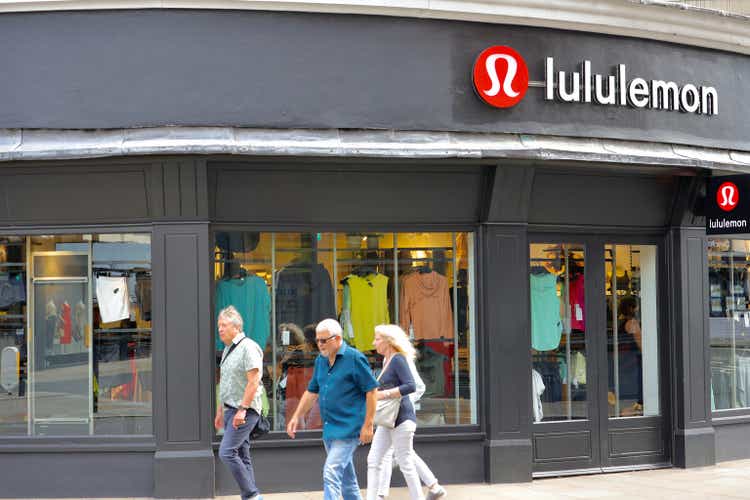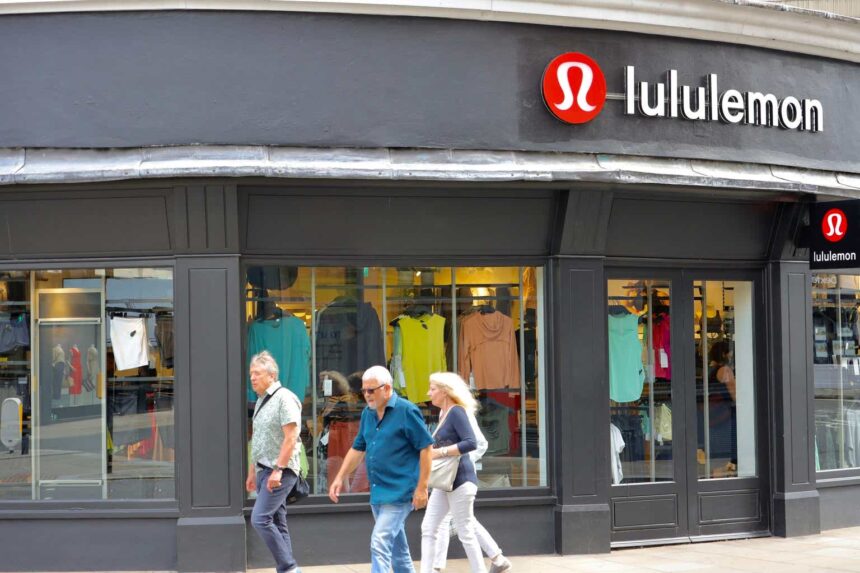yujie chen/iStock Editorial via Getty Images
“Prediction is hard, especially about the future.” That’s supposedly either a Yogi Berra quote or a Niels Bohr quote. Whatever the case, it’s a true statement.
As equity investors, we have to accept that stocks are forward-looking. How can we invest without trying to predict the future? I try to get around that a few ways, and one is by tweaking the goal. When looking at a stock, rather than predicting what will happen, I try to imagine the worst-case outcome and then what the best-case outcome might be. From there, the investment decision is about how likely one or the other type of outcome is, and how good the reward is versus the risk.
Which brings me to Lululemon (NASDAQ:LULU). LULU is an unusual stock for me. I don’t tend to buy high multiple stocks. I have trouble getting the retail sector right, and tend to avoid it. Furthermore, I prefer to invest in smaller companies with a better chance of identifying something the market is missing. But, I’ve built a pretty full-sized initial position (just under 2% of Middle Coast Investing’s portfolio) in Lululemon at an average price of $335.
I’ve achieved that full size because Lulu keeps dropping from where I started buying at $370. After disappointing guidance and transcript comments of a ‘somewhat challenging’ U.S. consumer environment, the athleisure company’s shares dropped nearly 20%. As analyst downgrades, executive departures, and rumbles of narrowing competitive edge continue to pick up, shares have dropped further, hitting new 52-week lows, some 40% below where we started the year.
This is what investors should want to happen when buying a stock, as long as their analysis is right. A sell-off makes it easier to average down in the near term. If the analysis is good, it will be proven right, over time, ideally after a year for long-term capital gains purposes.
But there is obviously market doubt out there about whether my analysis is right. Which leads me to this exercise: looking at how Lululemon’s worst-case scenario stacks up with more bullish outcomes.
I’ll be using a LULU share price of $300 for my analysis.
Why I Bought Lululemon shares
My basic Lululemon buy thesis has three components:
Lululemon has been head and shoulders above peers in the apparel space. Last fall, I opened and then quickly closed a small position in Levi’s (LEVI). In my research, I reviewed Levi’s financials vs. peers. LULU’s revenue and EPS growth, inventory management, balance sheet, and margins in recent years and over the longer term were in another ballpark from most of these legacy companies – your Ralph Laurens (RL), your American Eagles (AEO) and so on. LULU shares were quite expensive then, but I pinned that fundamental edge for later.
I should note that I neither made nor lost money on Levi’s, and its shares have since risen over 75% in 7–8 months. Another note of caution about my analysis.
I’ve also seen how popular Lululemon is among customers, and what its international growth runway might be. The first part is typical: my wife has been a long-time Lululemon shopper, and we have several friends who have bought the company’s clothes as well. I don’t want to overweight this anecdotal evidence, but it at least had Lululemon on my radar.
The second part comes from what I’ve seen living outside the U.S. For example, Lululemon has three stores in Spain – one in a department store in Madrid, one in the richest neighborhood in Madrid, and one in prime real estate on a main shopping street in Barcelona. Google trends data for Lululemon in various European countries (Germany, U.K., France, Spain) is trending higher and higher, while the company’s store counts in those countries remains quite low. Meanwhile, I see women wearing leggings everywhere, and a leggings brand like Calzedonia (privately held as part of the Calzedonia Group) is way bigger. Lululemon is further up market than Calzedonia, but I can see room for growth for a company like Lululemon. Its numbers speak to that, with mainland China comparable sales growing 39% and rest of world comparable sales 32% last year (page 30 of the 2023 10-K: actual sales grew 67% and 43%, respectively).
The last component is the sell-off. At $300, Lululemon trades at 21.2x analyst estimates for 2024 ($14.15/share, vs. management’s $14-14.20 guidance). The S&P 500 trades at 21.4x, 2024 estimates according to the WSJ.
Lululemon is trading at a market multiple. I believe the company will have above market growth revenue and profit growth. That’s the thesis, in two sentences.
What if it doesn’t have above-market growth? Let’s use a fallen peer to build a bear case.
The Under Armour Scenario
The two most tangible risks to Lululemon’s story are that it is a Covid winner that hasn’t yet had its hangover, and that it is just a fad. Under Armour (UAA) is the most similar apparel company that has fallen into fad status. Looking at UAA’s results can help us build out a Lululemon bear case.
I am no apparel expert, and won’t try to pinpoint reasons why Under Armour plummeted. I can point out, though, based on Under Armour 10-Ks that:
- Under Armour’s UAA shares peaked in 2015, and are down about 87% since.
- The company’s revenue grew at a 28.1% CAGR (compound annual growth rate) in the four years ending in 2015. It grew 7.4% per year the next four years, with much of that coming in 2016.
- EPS (earnings per share) grew only 3.5% per year in that hypergrowth stretch, split adjusted, and then declined 22% a year in the next four years.
- Operating income grew at a 25.9% CAGR from 2012-2015, then dropped 12.7% per year on average through 2019.
- Under Armour’s international revenue has grown at a 16.7% CAGR from 2016 to the most recent 12 months ending March 2024; North America revenues, however, have declined by 2% per year since then.
If Lululemon’s sales hit the exact same trajectory, LULU shares will continue to go down. There are differences in the company’s respective starting points, though. Lululemon is much more profitable than 2015-16 Under Armour: LULU’s operating margin was 22.2% last year; Under Armour’s 2015 operating margin was 10.3%. Lululemon shares are also cheaper than Under Armour’s were then – Lululemon’s peak PE (price-to-earnings) multiple in the last year was 42.4, and it is now 24.6x last year’s GAAP earnings. Under Armour’s lowest 2015 and 2016 multiples, per its 10-K, were between 45 and 56.
For my worst-case scenario, Lululemon matches Under Armour’s annual international growth rate of 16.7% through 2027, a meaningful slowdown, while LULU’s Americas sales remain flat through the entire period (the company is planning to open new stores in Americas this year, so this is fairly extreme). That amounts to a blended revenue CAGR of 5.4%.
I assume no gross margin change, and 50 basis points of operating expense increases per year, as LULU earns lower margins abroad (mainland China is close to the Americas, rest of world (ROW) is meaningfully lower). Lastly, I model LULU buying back shares with half of its free cash flow. And I still model rising capital expenditures even though the company would open very few new stores by 2027 under this scenario. Lastly, I use a terminal growth rate of 2%, in line with GDP.
Lululemon Bear Case Scenario DCF Model
|
LULU (figures in $M) |
2023 |
2024 |
2025 |
2026 |
2027 |
|
Revenue growth |
11.90% |
6.2% |
5.9% |
5.5% |
4.0% |
|
Revenue |
9619 |
10216 |
10822 |
11416 |
11870 |
|
Gross margin |
58.31% |
58.31% |
58.31% |
58.31% |
58.31% |
|
Opex |
36.14% |
36.64% |
37.14% |
37.64% |
38.64% |
|
Operating income |
2133 |
2214 |
2291 |
2360 |
2335 |
|
Interest |
-43.06 |
-43.06 |
-43.06 |
-43.06 |
-43.06 |
|
Tax |
28.8% |
30.0% |
28.75% |
28.75% |
28.75% |
|
Capex |
651.9 |
680 |
700 |
725 |
750 |
|
D&A |
379.4 |
400 |
425 |
450 |
475 |
|
Net income |
1550 |
1580 |
1663 |
1712 |
1694 |
|
Free cash flow |
1278 |
1300 |
1388 |
1437 |
1419 |
|
Shares outstanding |
126.008 |
124.5 |
123 |
122 |
121 |
|
EPS |
12.30 |
12.69 |
13.52 |
14.03 |
14.00 |
|
FCF/share |
10.14 |
10.44 |
11.29 |
11.78 |
11.73 |
|
P |
300 |
300 |
300 |
300 |
300 |
|
Net Debt |
-2243.97 |
-3000 |
-3650 |
-4350 |
-5050 |
|
Market Cap |
37802.4 |
37350 |
36900 |
36600 |
36300 |
|
EV |
35558.43 |
34350 |
33250 |
32250 |
31250 |
|
P/E |
24.4 |
23.6 |
22.2 |
21.4 |
21.4 |
|
P/FCF |
29.6 |
28.7 |
26.6 |
25.6 |
25.6 |
|
Cash-adjusted P/E |
22.9 |
21.7 |
20 |
18.8 |
18.4 |
|
Share buyback amount |
NA |
600 |
700 |
700 |
700 |
|
Discount rate |
NA |
10% |
10% |
10% |
10% |
|
PV of free cash flow |
NA |
1299.76 |
1261.88 |
1187.61 |
1066.32 |
|
4-year model |
|||||
|
Exit FCF |
1448 |
||||
|
Long-term growth rate |
2% |
||||
|
Terminal Value |
18096 |
||||
|
PV of cash flows |
4816 |
||||
|
EV |
22911 |
||||
|
MC |
27961 |
||||
|
Target price |
231 |
Do all that, and I get $14/share in earnings in 2027, and $5b in net cash. My DCF (discounted cash flow) model spits out a $231 fair value. Use Under Armour’s current cash-adjusted earnings multiple of 12.7, and I get a $219 price target. Let’s average those and say the downside is $225, 25% lower than $300.
We can argue over whether that’s the worst-case scenario, but it seems pretty bad to me. It flies in the face of management’s 10%+ revenue guidance for 2024. My 2027 earnings is the low end of management’s 2024 guidance. The business’s growth story would come to a halt almost immediately.
That’s a model of our risk. How about the reward?
Simple and complicated upside models
Lululemon has tended to double EPS every four years or fewer. 2012-2015 was its slowest earnings growth period of the last 12 years, at just under that doubling pace.
|
LULU historic performance |
2012-2015 CAGR |
2016-2019 CAGR |
2020-2023 CAGR |
|
Revenue |
26.1% |
16.3% |
30.8% |
|
EPS |
18.2% |
21.4% |
35.6% |
|
Op Income |
20.2% |
17.0% |
31.8% |
|
Free Cash Flow |
9.2% |
27.6% |
33.5% |
|
Shares outstanding |
0.1% |
-1.8% |
-1.3% |
|
Price return as of year-end |
3.0% |
45.0% |
21.9% |
Let’s say, Lululemon, powered by operational excellence, brand positioning, and continued growth internationally and in men’s clothing, takes five years to double its 2023 EPS. This would be its slowest compounded EPS growth rate, 14.9%, since 2012. Sticking to 2027 to align with my worst-case model, I get an EPS of $21.2 in 2027. Assigning a market multiple of 20 to shares and adding cash back in gets us to a price target $466. 55% upside.
Is that too bullish? Maybe, though I built in some conservatism by not giving LULU any multiple expansion. But let’s be more precise.
Let’s say a CAGR of 3.7% revenue growth in the Americas for the next 4 years (it was ~12% last year), 30% in China, and 24% in ROW. Total revenue CAGR of 9.9%. A lot slower than any stretch since 2011. I will also build in zero operating or gross profit leverage, and the same 50% of free cash flow used in buybacks. Doing that, I get $18.73 EPS in 2027. With our current market multiple and adding back cash, we’re at $419. 40% upside.
I think that the second case is a fairly conservative bull scenario, and my bear scenario is more extreme. The risk reward is 40% up vs. 25% down over the next 3–4 years. Not amazing.
But there’s room for Lululemon to outperform my conservative case: if it proves its outsized North American growth is not in the past, or gains operating leverage as it has in the past, or increases shareholder returns smartly, or accelerates its international growth plan. Any of these things could return Lululemon shares to their past above-market multiple status. If more than one of those things happen, investors at today’s price will do well. That’s what I am investing in.
A light in the fog
The future is hard in investing, but there are also periods where the present gets tough to understand.
Lululemon shares have sold off in such a way as to make one think, “somebody knows something I don’t.” Which is definitely a possibility here. Next week’s earnings will shed a lot of light, and could be an important report.
I wrote this post before that report not because I have any precise idea of how those earnings are going to go, nor because this quarter will be decisive for my thesis. I wrote it because we’re in the fog of the markets, where relatively little fundamental information from the company has triggered a major move. Which might create an opportunity.
I can’t say whether the market is ‘right’ to have sold LULU shares off. What’s easier is to try to spell out the boundaries for where Lululemon, on a fundamental basis, could go, and what that would mean for Lululemon shares, and then guess at what type of outcome is more probable.
I own Lululemon shares for myself and on my clients’ behalf because I think those boundaries portend good things for the risk/reward. We’ll get more information in a week on how that outline looks.







